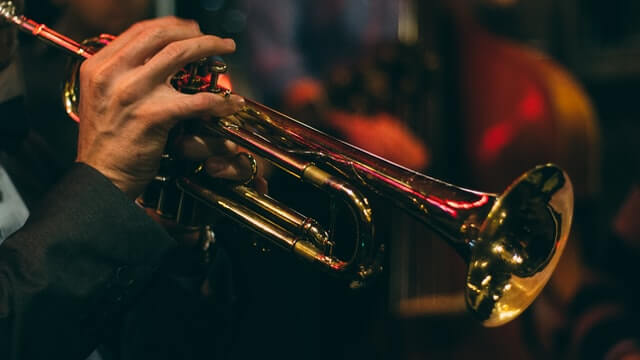Trombones are loud for a couple of reasons such as: how it is played, the length of the tube and the effort of the person playing it.
Trombone is a brass instrument, and among all the musical instruments the loudest of the brass family is Bugle, closely followed by Trombone. They can be heard above all other instruments, which is why they are often used in marching bands and on parades. Trombones can reach volumes of up to 115 decibels, which is much louder than a typical conversation (which is around 60 decibels) or a rock concert (which is around 100 decibels).
They are often played in marching bands and at sporting events, and their powerful sound can be heard from a great distance.
Reasons why trombones are so loud
The trombone is a brass instrument that produces an incredibly loud sound. It has the widest range of any brass instrument and can play everything from bass notes to high-pitched sound, depending on how you use your hands and mouth. And it’s also one of the most versatile instruments in classical music, with solo parts ranging from simple melodies to complex counterpoint. Here are the reasons why trombones are loud:
-
The technique of playing
The trombone is so loud because it creates sound by pushing air through a narrow tube which causes vibrations at both ends. The vibrations create waves which travel down the length of the tube and push against each other as they meet at its opening, causing even more vibration – or pressure – until there’s enough power to break free into our world as a powerful sound wave.
-
The length of the tube
The trombone is a brass instrument that uses a slide to change the length of the tubing, which affects the pitch of the note. This makes the trombone an adaptable instrument that can play a wide range of notes. The trombone is able to achieve projection thanks in part to the slide, which gives it a unique sound compared to other brass instruments and this can result in how loud they be.
The metal tubes of the trombone also amplify the sound, making it one of the loudest brass instruments. This is because the sound waves travel through the metal tubing and are amplified as they pass through the slides.
-
The skill and effort of the person playing
Trombones are often played in marching bands and at sporting events, where their powerful sound can be heard from a great distance. This makes them a perfect choice for providing music for large crowds of people. Their rich, full sound is sure to get everyone’s attention and create a festive atmosphere.
-
Large bells, Loud sound
The large bells also contribute significantly to loudness because they help conduct and amplify the sound waves produced by the vibrating lips of the player and they also use a lot of air pressure to produce their notes. The larger bore of a trombone allows it to resonate lower frequencies than other brass instruments.
Let’s take a closer look at the physics of sound and how trombones create such a powerful noise!
Physic of sound
A musical tone is a complex waveform made up of a fundamental frequency and overtones. The human ear detects these frequencies and the relative intensity between them to perceive different tones, or notes. A quiet note contains little energy or power in its upper regions, while a loud note has more concentrated energy in higher frequencies.
The volume of a tone is defined by its amplitude, which is the height of the waveform above or below a mid-point. A louder tone will have a larger amplitude than a quiet tone. But what causes loudness? The answer lies in the human ear’s response to different frequencies.
Lower notes tend to be quieter because human ears are more sensitive to high-pitched sounds. The ear is most sensitive in the midrange of audible frequencies, roughly between 2000 Hz and 5000 Hz. But very low or very high tones have less energy than middle tones, so they are also softer for this reason. The power in a sound is related to the amplitude squared, meaning that equally loud tones will be twice as powerful (a difference of 4 dB).
However, this difference is not linear like other amplitude ratios. For example, a sound with an amplitude of 0 dB is already 10 times more powerful than a sound at -10 dB. This means that trombone players can make their instrument louder relative to others by using stronger mouthpieces and adding more lip pressure to their instruments.
For a long time, the physics of sound was an active area of scientific research. For example, in 1660, Robert Hooke first proposed that sounds traveled through the air by compression waves similar to those formed when a stone is dropped into a pool of water. It wasn’t until 1738 that John Smeaton proved Hooke’s theory of sound was correct with his experiments on the subject.
Trombones can get pretty loud – even louder than trumpets. While the trumpet is known for its piercing sound, there are some surprising brass instruments that pack a greater sonic punch. The length of a trombone is twice that of a trumpet or saxophone, which means they have longer tubes to resonate sound waves. The longer the tube, the lower the pitch.
But trombone isn’t the only loud instrument, other loud brass instruments include:
- Bugle (Bb)
- Cornet (Bb and C)
- French horn (F)
- Mellophone (Eb and F)
These instruments are also often used in symphony orchestras, where they blend nicely with other lower brass instruments like the tuba and bass trombone. They may come in various shapes and sizes, but one thing is for sure: among all wind instruments, the trombone easily produces the loudest sounds!







